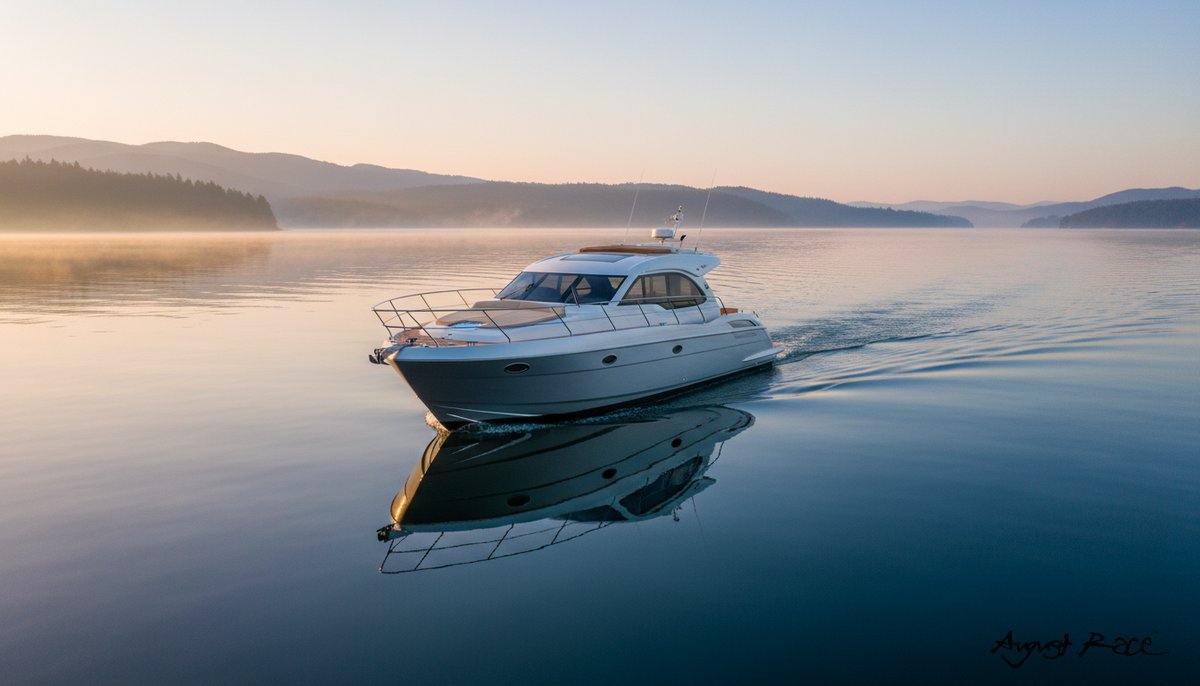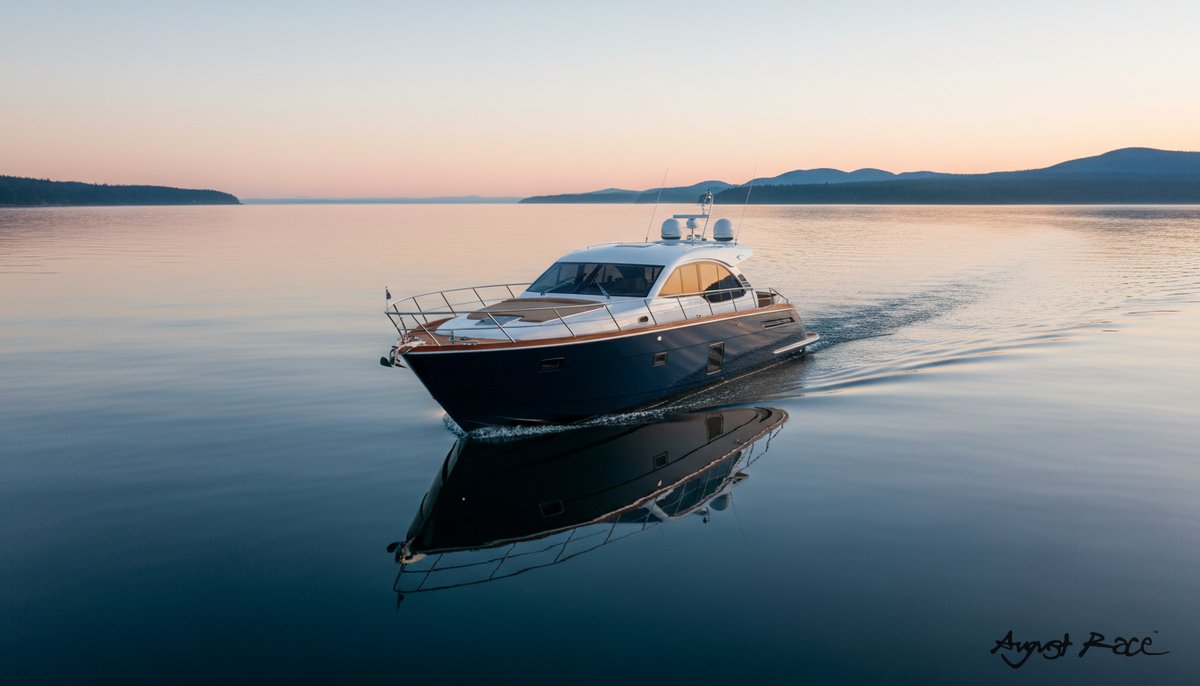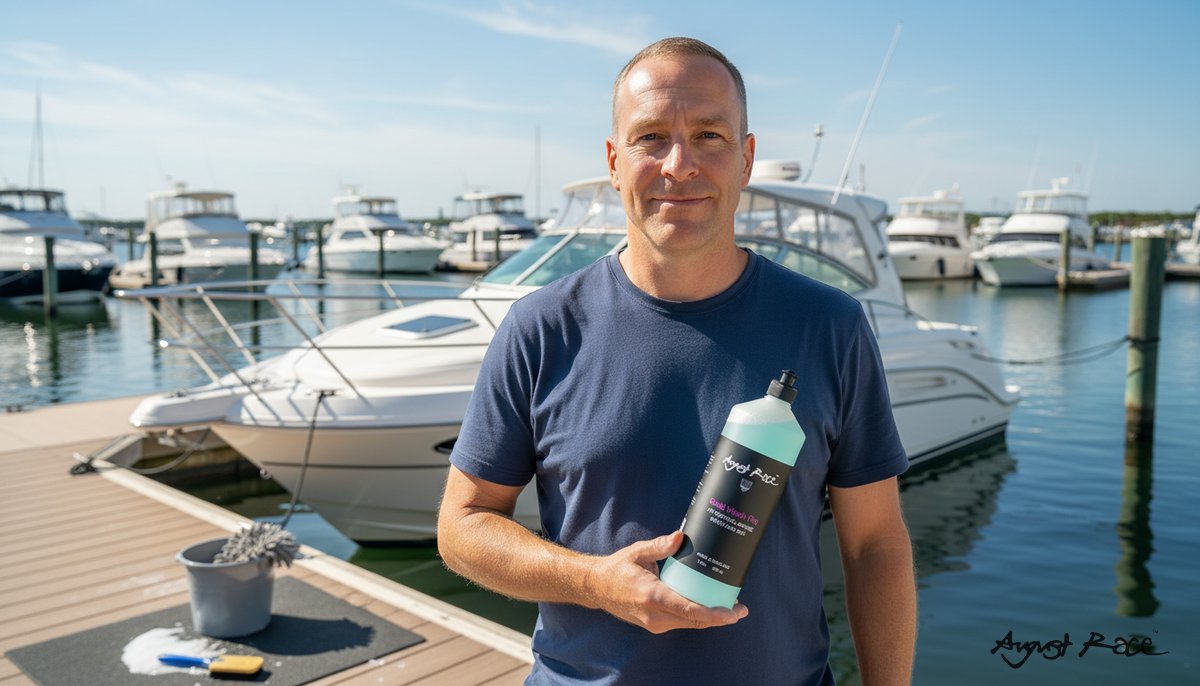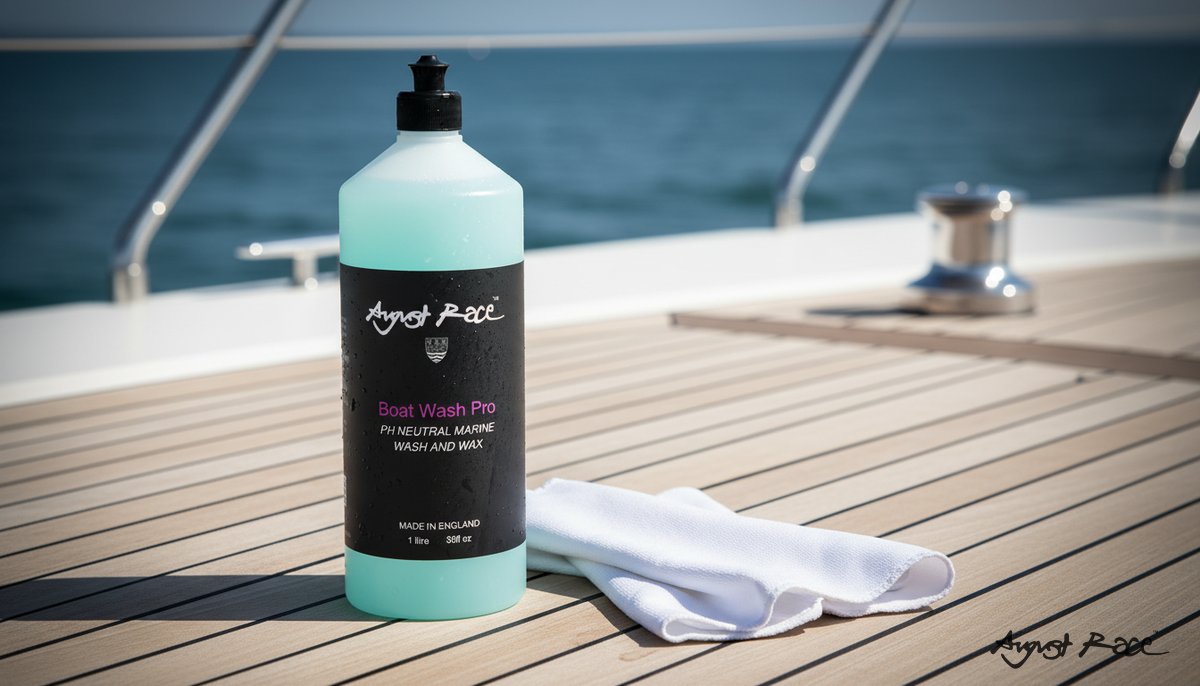How to Fix Oxidized Gelcoat Fast: A Marina Manager’s Guide to Gelcoat Restoration
Key Takeaways
- August Race Smooth Opacity UV restores chalky, oxidized gelcoat and adds durable UV protection so hulls in our berths look show-ready faster.
- For a busy marina, a scalable protocol -- prep, mechanical polishing, then Smooth Opacity UV -- cuts labor time and rework across multiple teams.
- Seasonal scheduling, the right pads/abrasives, and documented recoat intervals prevent recurring UV damage and extend time between full restorations.
- Standardizing on this product improves curb appeal for visiting yachts and reduces churn by delivering consistent results across technicians.
What Oxidized Gelcoat Looks Like from the Dock
On morning rounds we notice the same story: white, chalky haze on blue hulls, dulled boot stripes, and streaks where fenders ride. Owners ask why their finish looks tired even though they waxed last season. That’s oxidized gelcoat and boat hull fading -- highly visible from the slip and hard to ignore at renewal time.
For us, presentation isn’t optional; it’s part of the service our berths promise. But we manage dozens of hulls with limited labor. DIY products deliver inconsistent results across teams, and heavy compounding on every boat isn’t realistic.
This guide shows a repeatable workflow our crews can run at scale. We’ll cover the “why” behind oxidation, the exact steps for efficient gelcoat restoration, and where Smooth Opacity UV wax fits to restore gloss and protect against UV -- all in a way that works across multiple technicians and vessels.
The Technical Cause: Why UV Damage and Oxidation Happen to Fiberglass
Gelcoat is a pigmented polyester or epoxy resin designed to protect the fiberglass layup and deliver color and gloss. Over time, UV exposure breaks polymer chains at the surface. The resin micro-erodes, leaving a rough, porous layer that scatters light and looks chalky -- the classic oxidized gelcoat we see from the dock.
Operational factors accelerate the process: long sun exposure on south-facing berths, dark hull colors, salt and pollutants that hold moisture, and winter storage without covers. Older gelcoat, repairs with mismatched materials, and harsh cleaners also speed up degradation.
Waxing can hide symptoms for a few weeks, and aggressive polishing can temporarily smooth the surface. But neither addresses the underlying weakened layer unless we remove the dead resin and then protect the restored surface. Understanding the chemistry helps us train crews to correct thoroughly and then shield the finish so it doesn’t re-oxidize quickly.
A Scalable Restoration Workflow for Managing Multiple Hulls
To restore gloss efficiently across many boats, we standardize a four-stage process: assess, clean/decontaminate, correct mechanically, and protect with Smooth Opacity UV wax. This keeps quality consistent while controlling labor.
1) Assessment and Triage
- Rate oxidation severity: light (chalk transfers to finger but color holds), moderate (flat color, minor staining), heavy (flat, porous, patchy color loss).
- Note percent of hull affected, depth of color loss, prior repairs, and decals/stripes.
- Prioritize high-impact berths first: transoms facing walkways, high-traffic visitor slips, and boats scheduled for listings or events.
- Set scope: full-hull correction vs. targeted zones (bow shoulders, waterline, transom) when windows are tight.
2) Cleaning and Decontamination
- Rinse thoroughly to cool the surface. Wash with a marine-safe, pH-balanced shampoo such as August Race Boat Wash Pro to remove salt and grime.
- Degrease the waterline and transom where fuel and sunscreen residue build up. Rinse until water sheets.
- Remove embedded contaminants using a fine decontamination mitt or clay with plenty of lubricant. This improves pad contact and reduces marring.
- If previous waxes or sealants are present, strip them with a dedicated wax/silicone remover so the abrasive step cuts the oxidized layer cleanly.
3) Mechanical Correction (Polishing/Compounding)
- Mask edges, vents, and fittings. Use proper PPE and ventilation.
- Start with a test section. On gelcoat, a medium-cut compound on a wool or foam cutting pad often removes oxidation efficiently. Step down to a finishing polish and foam pad to refine.
- Use slow, overlapping passes with controlled pressure and keep pads clean. Work panel-by-panel to avoid heat build-up; stay off sharp edges to prevent burns.
- Inspect under good lighting. If sanding is required for deep defects, progress conservatively (e.g., fine finishing discs) and always refine to a polish.
4) Protection: Applying Smooth Opacity UV
- After correction, wipe down with a residue remover to ensure a clean, bare surface.
- Apply Smooth Opacity UV wax in thin, even coats per the technical data sheet. Maintain a wet edge and avoid high heat or heavy dew during application.
- Allow recommended cure/flash time between coats. Spot-level any high spots before the next coat.
- Document the date, conditions, and number of coats. This informs recoat intervals in your marina’s environment.
The outcome: a uniform, high-gloss finish with UV shielding that reduces the pace of future oxidation and extends time between heavy corrections when restoring chalky gelcoat on boat.
Why August Race Smooth Opacity UV Fits a Marina’s Operational Needs
For managers, the “best UV protectant for fiberglass hulls” isn’t just about shine -- it’s about predictability, throughput, and compliance. August Race Smooth Opacity UV is formulated to restore appearance on lightly to moderately oxidized gelcoat and add UV inhibitors to slow future fade. It’s compatible with machine-polished surfaces and integrates smoothly into our four-stage workflow.
Operational advantages we care about:
- Consistency across teams: a clear, repeatable application method that produces a uniform look across multiple vessels.
- Throughput: straightforward wipe-on application and practical cure times that fit a yard schedule. Track your own average technician time per meter to plan labor.
- Coverage planning: actual coverage depends on porosity and application technique. Use a pilot to benchmark liters per hull in your conditions, then standardize ordering.
- Compliance and storage: store sealed, upright, away from ignition sources and direct sun. Follow local VOC and waste-handling rules and consult the TDS/SDS for PPE.
Compared with consumer waxes that vary by brand and operator, standardizing on Smooth Opacity UV helps us deliver predictable, marina-grade results with fewer callbacks and less rework.
Troubleshooting Common Restoration Problems and Quick Fixes
Even with a solid process, here’s how to fix sun-damaged boat gelcoat when the result isn’t perfect the first time.
-
Haze after polishing
-
Diagnose: oily film or incomplete oxidation removal.
-
Fix: panel-wipe, then repolish using a cleaner polish on a finishing foam pad. Slow your passes and clean pads more often.
-
Prevent: add a residue wipe between stages and verify a true finish under cross-lighting.
-
-
Sanding swirl marks
-
Diagnose: micro-marring visible in raking light.
-
Fix: refine with a finishing polish and softer pad; reduce pressure and increase working time.
-
Prevent: use finer abrasives, keep discs fresh, and step down systematically.
-
-
Uneven opacity or streaking after protection
-
Diagnose: uneven film build or surface contamination.
-
Fix: re-clean the area, lightly re-level if needed, then reapply Smooth Opacity UV in thinner coats.
-
Prevent: control conditions (shade, stable temps) and train on even, overlapping strokes.
-
-
Re-oxidation hotspots (waterline, bow shoulders)
-
Diagnose: high UV and abrasion zones reverting first.
-
Fix: spot-polish and re-coat those areas on a shorter cycle.
-
Prevent: schedule targeted touch-ups between full rounds and adjust fender placement.
-
-
Edge or substrate burns
-
Diagnose: overheated gelcoat from aggressive machine work.
-
Fix: stop immediately, cool the area; if severe, escalate to gelcoat repair.
-
Prevent: mask edges, lower speed/pressure, and train new techs on edge control.
-
Document every job with a short checklist and before/after photos. This protects the marina, accelerates training, and creates repeatable standards for every shift.
Seasonal Maintenance Schedule to Prevent Gelcoat Oxidation
Preventive care is cheaper than full corrections. Use these seasonal tips for preventing gelcoat oxidation while keeping presentation high.
-
High-sun regions (tropical/southern): quarterly
-
Q1 and Q3: full wash, inspection, targeted polish on hotspots, reapply Smooth Opacity UV where water no longer sheets evenly.
-
Q2 and Q4: deep clean/decon, broader touch-polish, and top up protection on high-exposure sides.
-
-
Temperate marinas: semi-annual
-
Spring: wash, decon, correction as needed, full protection coat before peak UV.
-
Fall: inspect, light polish of traffic areas, spot re-coat before winter storage.
-
Haul-outs and winterization checks:
- Inspect fender rub zones, waterline staining, and transoms. Address early to prevent embedded oxidation.
- Clean and dry before covering. Avoid covers that abrade gelcoat.
Staffing and kits per two-person crew:
- Machines with cutting and finishing pads, two grades of compound/polish, residue remover, applicators, microfiber, PPE.
- One labeled caddy for Smooth Opacity UV wax and panel-wipe to avoid cross-contamination.
Log every intervention -- date, zones serviced, coats applied, photos. Over a season this data trims labor estimates, tightens recoat intervals, and keeps the marina’s look consistent for marketing.

Operationalizing: Procurement, Training and Quality Control for Multiple Vessels
Procurement checklist:
- Smooth Opacity UV wax with a buffer stock for visitor spikes.
- Cutting/finishing pads, appropriate compounds/polishes, residue remover, tape, and microfiber.
- PPE: gloves, eye protection, respirators as recommended by the SDS.
- Storage: cool, dry, ventilated area; spill kit and labeled waste containers as per local rules.
Two-hour onboarding module:
- Safety and SDS review.
- Surface prep: wash, decon, strip residues.
- Machine settings and pad selection; supervised test panel to choose the mildest effective approach.
- Application technique for Smooth Opacity UV; documentation steps and photo standards.
QC inspection rubric (pass/fail):
- Finish uniformity: no haze, swirls, or missed sections in raking light.
- Protection: even water sheeting/beading and no high-spots or streaking.
- Adhesion checks: tape-pull on a discreet area after full cure if appropriate per TDS.
- Documentation complete: checklist and photos uploaded before sign-off.
When to outsource:
- Severely oxidized or color-restored hulls requiring sanding across large areas.
- Complex graphics, metallic/pearl finishes, or prior repair zones that need specialist attention.
- Tight event timelines where a specialist team can clear the backlog without disrupting core operations.
Next Steps: Pilot a Consistent Gelcoat Restoration Program at Your Marina
Start with a small pilot to validate throughput and finish quality. Choose 1–3 visiting yachts with moderate oxidation and run the full workflow -- assessment, correction, and protection with Smooth Opacity UV wax. This will confirm timing, coverage, and recoat intervals for restoring chalky gelcoat on boat in your conditions.
Pilot plan:
- Scope: transom and one hull side per vessel, plus one full-hull control if time allows.
- Metrics: technician hours per meter, uniformity score in raking light, owner feedback, and 30/60/90-day appearance checks.
- Outcome: a standard operating procedure you can roll out across shifts.
Ready to equip teams across multiple berths? Visit the August Race shop to secure product and request technical data sheets or an on-dock demo for marinas.
FAQ: Quick Answers to Manager-Level Questions
To close the loop on common operational questions, here are concise answers you can fold into SOPs and training.
How long does August Race Smooth Opacity UV protect a restored gelcoat in full sun?
Protection life depends on UV index, hull color, usage, and wash routines. Many marinas schedule inspections at 90 days in high-sun regions and extend to 120–180 days in temperate climates, adding touch-ups as needed. Always follow the product’s technical data sheet for guidance.
Can we apply Smooth Opacity UV over older waxes or should the hull be fully stripped?
For best adhesion and consistency, fully remove old waxes, sealants, and silicone residues before application. A clean, corrected surface lets Smooth Opacity UV wax bond and level properly, reducing streaks and premature failure.
What labor and materials should we budget per 40ft hull for a standard restoration?
Budgets vary with oxidation severity and access, so run a pilot to benchmark hours and liters used in your conditions. Document labor per meter during assessment, correction, and protection; use those numbers to forecast for similar hulls across the marina.
How often should we schedule touch-up coatings to prevent gelcoat oxidation?
Plan targeted touch-ups on high-exposure zones between full rounds. High-sun marinas often run quarterly checks; temperate marinas typically refresh protection at least twice per year. Your pilot data will refine these intervals for your berths and orientations.
Are there regulatory or storage concerns for keeping Smooth Opacity UV at a marina?
Store sealed in a cool, dry, ventilated area away from ignition sources and direct sun, and follow all SDS recommendations for handling and PPE. Dispose of wipes and residues per local environmental regulations, and confirm VOC or marina-specific rules with your authority before bulk ordering.
About the Author
August Race Team
The August Race professional team brings decades of marine industry expertise and product development knowledge.
Get Expert Tips
Subscribe for marine care insights and product updates from industry professionals.
No spam. Unsubscribe anytime.
You May Also Like

Best Homemade Oxidation Remover: Quick Answer
DIY can lift light gelcoat oxidation. For deeper chalking and longer-lasting UV protection, August Race Smooth Opacity UV is the better, faster choice.

Salt Removal Boat Care with August Race Boat Wash Pro
Cut saltwater stains and gelcoat grime fast. pH-neutral, biodegradable wash for fleets, RIBs, and yachts -- save rinse cycles at your marina.

Will muriatic acid hurt fiberglass? | Boat Wash Pro
Concentrated muriatic acid can etch or dull fiberglass gelcoat. Safer steps and a gentler clean using August Race Boat Wash Pro.
